
Power of Infrared and Raman Spectroscopies to Characterize Metal-Organic Frameworks and Investigate Their Interaction with Guest Molecules
Chemical Reviews Pub Date : 2020-12-14 ,
DOI: 10.1021/acs.chemrev.0c00487
Konstantin I. Hadjiivanov; Dimitar A. Panayotov; Mihail Y. Mihaylov; Elena Z. Ivanova; Kristina K. Chakarova; Stanislava M. Andonova; Nikola L. Drenchev
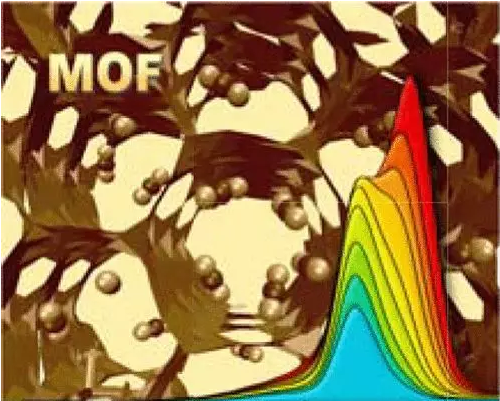
The variety of functionalities and porous structures inherent to metal-organic frameworks (MOFs) together with the facile tunability of their properties makes these materials suitable for a wide range of existing and emerging applications. Many of these applications are based on processes involving interaction of MOFs with guest molecules. To optimize a certain process or successfully design a new one, a thorough knowledge is required about the physicochemical characteristics of materials and the mechanisms of their interaction with guest molecules. To obtain such important information, various complementary analytical techniques are applied, among which vibrational spectroscopy (IR and Raman) plays an important role and is indispensable in many cases. In this review, we critically examine the reported applications of IR and Raman spectroscopies as powerful tools for initial characterization of MOF materials and for studying processes of their interaction with various gases. Both the advantages and the limitations of the technique are considered, and the cases where IR or Raman spectroscopy is preferable are highlighted. Peculiarities of MOFs interaction with specific gases and some inconsistent band assignments are also emphasized. Summarizing the broad analytical possibilities of the IR and Raman spectroscopies, we conclude that it can be applied in combinations with other techniques to explicitly establish the structure, properties, and reactivity of MOFs.
https://pubs.acs.org/doi/abs/10.1021/acs.chemrev.0c00487
Optoelectronic processes in covalent organic frameworks
Chemical Society Reviews Pub Date : 2020-12-17 ,
DOI: 10.1039/d0cs00793e
Niklas Keller and Thomas Bein
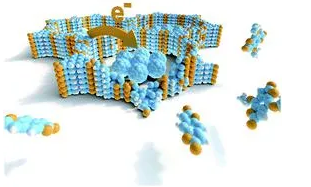
Covalent organic frameworks (COFs) are crystalline porous materials constructed from molecular building blocks using diverse linkage chemistries. Their modular construction system allows not only for tailor-made design but also for an immense variety of building blocks, opening the door to numerous different functionalities and potential applications. As a consequence, a large number of building blocks that can act as light-harvesters, semiconductors, ligands, binding sites or redox centers have recently been integrated into the scaffolds of COFs. This unique combination of reticular chemistry with the molecular control of intrinsic properties paves the way towards the design of new semiconducting materials for (opto-)electronic applications such as sensors, photocatalysts or -electrodes, supercapacitor and battery materials, solar-harvesting devices or light emitting diodes. With new developments regarding the linkage motif, highly stable but still tunable COFs have been developed for applications even under harsh conditions. Further, the molecular stacking modes and distances in the COFs have been investigated as a powerful means to control optical and electrical characteristics of these self-assembled frameworks. Advanced understanding of optoelectronic processes in COFs has enabled their implementation in optoelectronic devices with promising potential for real-world applications. This review highlights the key developments of design concepts for the synthesis of electro- and photoactive COFs as well as our understanding of optoelectronic processes in these frameworks, hence establishing a new paradigm for the rational construction of well-defined novel optoelectronic materials and devices.
https://pubs.rsc.org/en/content/articlelanding/2021/cs/d0cs00793e
High-Mobility Semiconducting Two-Dimensional Conjugated Covalent Organic Frameworks with p-Type Doping
Journal of the American Chemical Society Pub Date : 2020-12-17 ,
DOI: 10.1021/jacs.0c10482
Mingchao Wang; Mao Wang; Hung-Hsuan Lin; Marco Ballabio; Haixia Zhong; Mischa Bonn; Shengqiang Zhou; Thomas Heine; Enrique Cánovas; Renhao Dong; Xinliang Feng
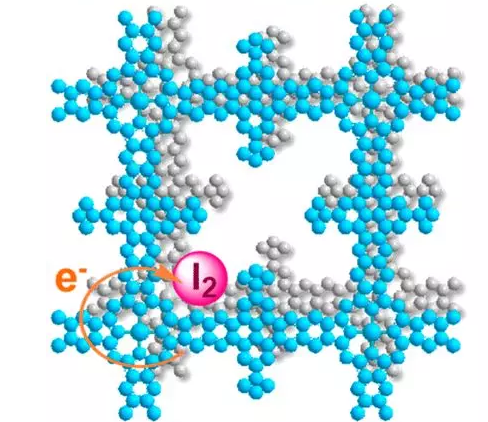
Two-dimensional conjugated covalent organic frameworks (2D c-COFs) are emerging as a unique class of semiconducting 2D conjugated polymers for (opto)electronics and energy storage. Doping is one of the common, reliable strategies to control the charge carrier transport properties, but the precise mechanism underlying COF doping has remained largely unexplored. Here we demonstrate molecular iodine doping of a metal–phthalocyanine-based pyrazine-linked 2D c-COF. The resultant 2D c-COF ZnPc-pz-I2 maintains its structural integrity and displays enhanced conductivity by 3 orders of magnitude, which is the result of elevated carrier concentrations. Remarkably, Hall effect measurements reveal enhanced carrier mobility reaching ~22 cm2 V–1 s–1 for ZnPc-pz-I2, which represents a record value for 2D c-COFs in both the direct-current and alternating-current limits. This unique transport phenomenon with largely increased mobility upon doping can be traced to increased scattering time for free charge carriers, indicating that scattering mechanisms limiting the mobility are mitigated by doping. Our work provides a guideline on how to assess doping effects in COFs and highlights the potential of 2D c-COFs to display high conductivities and mobilities toward novel (opto)electronic devices.
https://pubs.acs.org/doi/abs/10.1021/jacs.0c10482
A nitrogen-rich covalent organic framework for simultaneous dynamic capture of iodine and methyl iodide
Chem Pub Date : 2020-12-18 ,
DOI: 10.1016/j.chempr.2020.11.024
Linwei He; Long Chen; Xinglong Dong; Shitong Zhang; Mingxing Zhang; Xing Dai; Xiajie Liu; Peng Lin; Kunfeng Li; Cailing Chen; Tingting Pan; Fuyin Ma; Junchang Chen; Mengjia Yuan; Yugang Zhang; Lei Chen; Ruhong Zhou; Yu Han; Shuao Wang
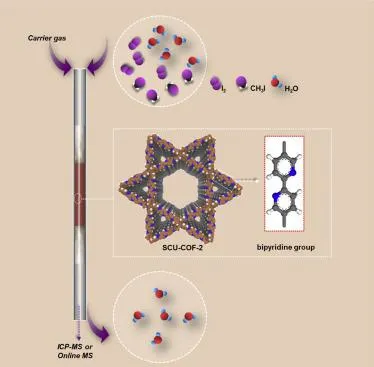
The capture of radioiodine species during nuclear fuel reprocessing and nuclear accidents is crucial for nuclear safety, environmental protection, and public health. Previously reported emerging materials for iodine uptake cannot outperform commercial zeolites and active carbon under the practical dynamic scenario. Herein, we present a new design philosophy aiming at significantly enhanced specific host-guest interactions and obtain a nitrogen-rich covalent organic framework material by introducing a bipyridine group into the building block for the simultaneous capture of both iodine gas through enhanced electron-pair effect and organic iodide via the methylation reaction. These efforts give rise to not only an ultrahigh uptake capacity of 6.0 g g−1 for iodine gas and a record-high value of 1.45 g g−1 for methyl iodide under static sorption conditions but also, more importantly, a record-high iodine loading capability under dynamic conditions demonstrated from the breakthrough experiments.
https://www.sciencedirect.com/science/article/abs/pii/S2451929420306318
Three-Dimensional Covalent Organic Framework with ceq Topology
Journal of the American Chemical Society ( IF 14.612 ) Pub Date : 2020-12-17 , DOI: 10.1021/jacs.0c11313
Zonglong Li; Li Sheng; Hangchao Wang; Xiaolin Wang; Mingyang Li; Yulong Xu; Hao Cui; Haitian Zhang; Hongmei Liang; Hong Xu; Xiangming He
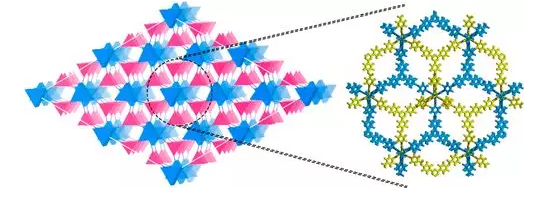
Three-dimensional covalent organic frameworks (3D-COFs) are emerging as designable porous materials because of their unique structural characteristics and porous features. However, because of the lack of 3D organic building units and the less reversible covalent bonds, the topologies of 3D-COFs to date have been limited to dia, ctn, ffc, bor, rra, srs, pts, lon, stp, acs, tbo, bcu, and fjh. Here we report a 3D-COF with the ceq topology utilizing a D3h-symmetric triangular prism vertex with a planar triangular linker. The as-synthesized COF displays a twofold-interpenetrated structure with a Brunauer–Emmett–Teller surface area of 1148.6 m2 g–1. Gas sorption measurements revealed that 3D-ceq-COF could efficiently absorb CO2, CH4, and H2 under a moderate surface area. This work provides new building units and approaches for structural and application exploration of 3D-COFs.
https://pubs.acs.org/doi/abs/10.1021/jacs.0c11313
Linker Substituents Control the Thermodynamic Stability in Metal–Organic Frameworks
Journal of the American Chemical Society Pub Date : 2020-12-16 ,
DOI: 10.1021/jacs.0c09284
Novendra Novendra; Joseph M. Marrett; Athanassios D. Katsenis; Hatem M. Titi; Mihails Arhangelskis; Tomislav Friščić; Alexandra Navrotsky
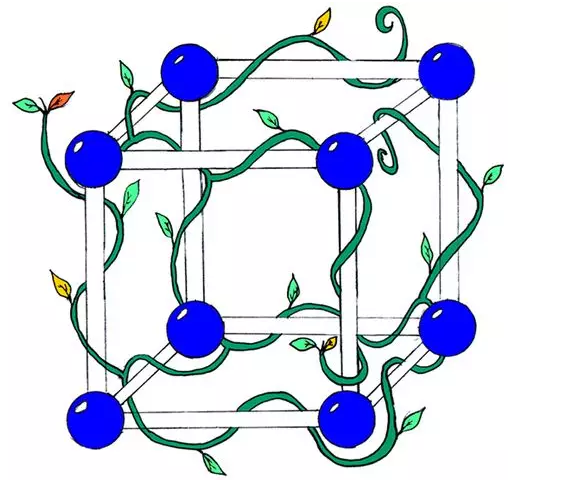
We report the first systematic experimental and theoretical study of the relationship between the linker functionalization and the thermodynamic stability of metal–organic frameworks (MOFs) using a model set of eight isostructural zeolitic imidazolate frameworks (ZIFs) based on 2-substituted imidazolate linkers. The frameworks exhibit a significant (30 kJ·mol–1) variation in the enthalpy of formation depending on the choice of substituent, which is accompanied by only a small change in molar volume. These energetics were readily reproduced by density functional theory (DFT) calculations. We show that these variations in the enthalpy of MOF formation are in linear correlation to the readily accessible properties of the linker substituent, such as the Hammett σ-constant or electrostatic surface potential. These results provide the first quantifiable relationship between the MOF thermodynamics and the linker structure, suggesting a route to design and tune MOF stability.
https://pubs.acs.org/doi/abs/10.1021/jacs.0c09284
Operando Investigation of Toluene Oxidation over 1D [email protected]2 Derived from Pt Cluster-Containing MOF
Journal of the American Chemical Society Pub Date : 2020-12-15 ,
DOI: 10.1021/jacs.0c08640
Qingyue Wang; Yuxin Li; Ana Serrano-Lotina; Wei Han; Raquel Portela; Ruixuan Wang; Miguel A. Bañares; King Lun Yeung
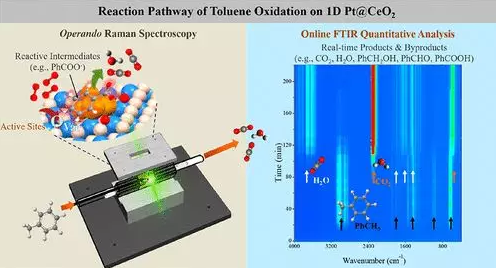
A unique 1D nanostructure of [email protected]2–BDC was prepared from [email protected] MOF. The [email protected]2–BDC was rich in oxygen vacancies (i.e., XPS Oβ/(Oα + Oβ) = 39.4%), and on the catalyst, the 2 nm Pt clusters were uniformly deposited on the 1D mesoporous polycrystalline CeO2. Toluene oxidation was conducted in a spectroscopic operando Raman–online FTIR reactor to elucidate the reaction mechanism and establish the structure–activity relationship. The reaction proceeds as follows: (I) adsorption of toluene as benzoate intermediates on [email protected]2–BDC at low temperature by reaction with surface peroxide species; (II) reaction activation and ring-opening involving lattice oxygen with a concomitant change in defect densities indicative of surface rearrangement; (III) complete oxidation to CO2 and H2O by lattice oxygen and reoxidation of the reduced ceria with consumption of adsorbed oxygen species. The Pt clusters, which mainly exist as Pt2+ with minor amounts of Pt0 and Pt4+ on the surface, facilitated the adsorption and reaction activation. The Pt-CeO2 interface generates reduced ceria sites forming nearby adsorbed peroxide at low temperature that oxidize toluene into benzoate species by a Langmuir–Hinshelwood mechanism. As the reaction temperature increases, the role of lattice oxygen becomes important, producing CO2 and H2O mainly by the Mars-van Krevelen mechanism.
https://pubs.acs.org/doi/abs/10.1021/jacs.0c08640
Luminescent Ratiometric Thermometers Based on a 4f–3d Grafted Covalent Organic Framework to Locally Measure Temperature Gradients During Catalytic Reactions
Angewandte Chemie International Edition Pub Date : 2020-11-10 ,
DOI: 10.1002/anie.202013377
Anna M. Kaczmarek; Himanshu Sekhar Jena; Chidharth Krishnaraj; Hannes Rijckaert; Savita K. P. Veerapandian; Andries Meijerink; Pascal Van Der Voort
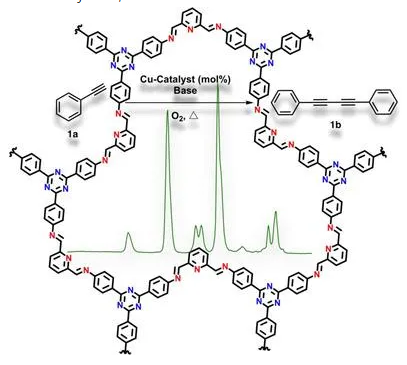
Covalent Organic Frameworks (COFs), an emerging class of crystalline porous materials, are a new type of support for grafting lanthanide ions (Ln3+), which can be employed as ratiometric luminescent thermometers. In this work we have shown that COFs co‐grafted with lanthanide ions (Eu3+, Tb3+) and Cu2+ (or potentially other d‐metals) can synchronously be employed both as a nanothermometer and catalyst during a chemical reaction. The performance of the thermometer could be tuned by changing the grafted d‐metal and solvent environment. As a proof of principle, the Glaser coupling reaction was investigated. We show that temperature can be precisely measured during the course of the catalytic reaction using luminescence thermometry. This concept could be potentially easily extended to other catalytic reactions by grafting other d‐metal ions on the Ln@COF platform.
https://onlinelibrary.wiley.com/doi/abs/10.1002/anie.202013377
Intermediate Binding Control Using Metal–Organic Frameworks Enhances Electrochemical CO2 Reduction
Journal of the American Chemical Society Pub Date : 2020-12-15 ,
DOI: 10.1021/jacs.0c10774
Dae-Hyun Nam; Osama Shekhah; Geonhui Lee; Arijit Mallick; Hao Jiang; Fengwang Li; Bin Chen; Joshua Wicks; Mohamed Eddaoudi; Edward H. Sargent
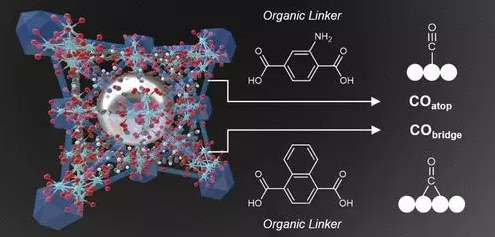
In the electrochemical CO2 reduction reaction (CO2RR), control over the binding of intermediates is key for tuning product selectivity and catalytic activity. Here we report the use of reticular chemistry to control the binding of CO2RR intermediates on metal catalysts encapsulated inside metal–organic frameworks (MOFs), thereby allowing us to improve CO2RR electrocatalysis. By varying systematically both the organic linker and the metal node in a face-centered cubic (fcu) MOF, we tune the adsorption of CO2, pore openness, and Lewis acidity of the MOFs. Using operando X-ray absorption spectroscopy (XAS) and in situ Raman spectroscopy, we reveal that the MOFs are stable under operating conditions and that this tuning plays the role of optimizing the *CO binding mode on the surface of Ag nanoparticles incorporated inside the MOFs with the increase of local CO2 concentration. As a result, we improve the CO selectivity from 74% for Ag/Zr-fcu-MOF-1,4-benzenedicarboxylic acid (BDC) to 94% for Ag/Zr-fcu-MOF-1,4-naphthalenedicarboxylic acid (NDC). The work offers a further avenue to utilize MOFs in the pursuit of materials design for CO2RR.
https://pubs.acs.org/doi/abs/10.1021/jacs.0c10774
An Enantioselective e‐Nose: An array of Nanoporous Homochiral MOF Films for Stereospecific Sensing of Chiral Odors
Angewandte Chemie International Edition Pub Date : 2020-11-06 ,
DOI: 10.1002/anie.202013227
Salih Okur; Peng Qin; Abhinav Chandresh; Chun Li; Zejun Zhang; Ulrich Lemmer; Lars Heinke

Chirality is essential in nature and often pivotal for biological information transfer, for example, via odor messenger molecules. While the human nose can distinguish the enantiomers of many chiral odors, the technical realization by an artificial sensor or an electronic nose, e‐nose, remains a challenge. Herein, we present an array of six sensors coated with nanoporous metal–organic framework (MOF) films of different homochiral and achiral structures, working as an enantioselective e‐nose. While the achiral‐MOF‐film sensors show identical responses for both isomers of one chiral odor molecule, the responses of the homochiral MOF films differ for different enantiomers. By machine learning algorithms, the combined array data allow the stereoselective identification of all compounds, here tested for five pairs of chiral odor molecules. We foresee the chiral‐MOF‐e‐nose, able to enantioselectively detect and discriminate chiral odors, to be a powerful approach towards advanced odor sensing.
https://onlinelibrary.wiley.com/doi/full/10.1002/anie.202013227
Diels–Alder Conversion of Acrylic Acid and 2,5‐Dimethylfuran to para‐Xylene Over Heterogeneous Bi‐BTC Metal‐Organic Framework Catalysts Under Mild Conditions
Angewandte Chemie International Edition Pub Date : 2020-12-15 ,
DOI: 10.1002/anie.202015607
Jyun‐Yi Yeh; Season S. Chen; Shih‐Cheng Li; Celine H. Chen; Tetsuya Shishido; Daniel C. W. Tsang; Yusuke Yamauchi; Yi‐Pei Li; Kevin C.‐W. Wu
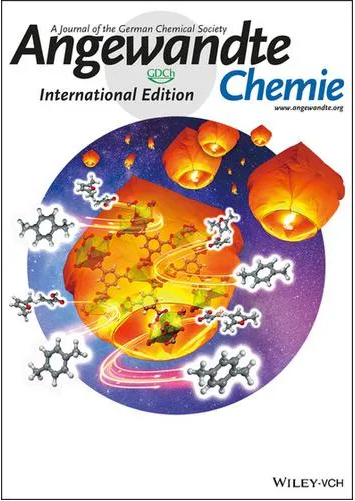
Heterogeneous Bi‐BTC catalyzes the formation of para‐xylene from bio‐based 2,5‐dimethylfuran and acrylic acid in 92 % yield at relatively mild conditions (160 °C, 10 bar). The reaction strategy enables a remarkable versatility for furan derivatives such as furan and 2‐methylfuran, as demonstrated by Kevin C.‐W. Wu et al. in their Communication (DOI: 10.1002/anie.202013061).
https://onlinelibrary.wiley.com/doi/10.1002/anie.202013061
Encoding Multilayer Complexity in Anti‐Counterfeiting Heterometallic MOF‐based Optical Tags
Angewandte Chemie International Edition Pub Date : 2020-12-15 ,
DOI: 10.1002/anie.202015605
Jacob I. Deneff; Kimberly S. Butler; Lauren E. S. Rohwer; Charles J. Pearce; Nichole R. Valdez; Mark A. Rodriguez; Ting S. Luk; Dorina F. Sava Gallis
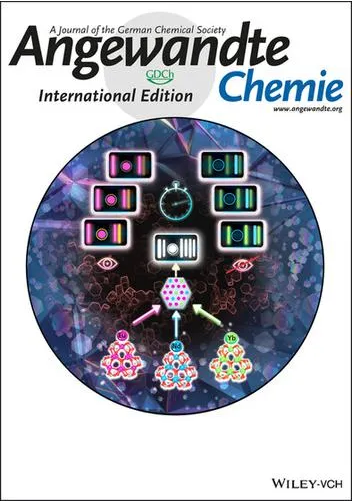
Optical tags provide a way to quickly and unambiguously identify valuable assets. Current tag fluorophore options lack the tunability to allow combined methods of encoding in a single material. Herein we report a design strategy to encode multilayer complexity in a family of heterometallic rare‐earth metal–organic frameworks based on highly connected nonanuclear clusters. To impart both intricacy and security, a synergistic approach was implemented resulting in both overt (visible) and covert (near‐infrared, NIR) properties, with concomitant multi‐emissive spectra and tunable luminescence lifetimes. Tag authentication is validated with a variety of orthogonal detection methodologies. Importantly, the effect induced by subtle compositional changes on intermetallic energy transfer, and thus on the resulting photophysical properties, is demonstrated. This strategy can be widely implemented to create a large library of highly complex, difficult‐to‐counterfeit optical tags.
https://onlinelibrary.wiley.com/doi/10.1002/anie.202013012
Configurational Entropy Driven High‐Pressure Behaviour of a Flexible Metal–Organic Framework (MOF)
Angewandte Chemie International Edition Pub Date : 2020-12-15 ,
DOI: 10.1002/anie.202015816
Pia Vervoorts; Julian Keupp; Andreas Schneemann; Claire L. Hobday; Dominik Daisenberger; Roland A. Fischer; Rochus Schmid; Gregor Kieslich

Flexible metal–organic frameworks (MOFs) show large structural flexibility as a function of temperature or (gas)pressure variation, a fascinating property of high technological and scientific relevance. The targeted design of flexible MOFs demands control over the macroscopic thermodynamics as determined by microscopic chemical interactions and remains an open challenge. Herein we apply high‐pressure powder X‐ray diffraction and molecular dynamics simulations to gain insight into the microscopic chemical factors that determine the high‐pressure macroscopic thermodynamics of two flexible pillared‐layer MOFs. For the first time we identify configurational entropy that originates from side‐chain modifications of the linker as the key factor determining the thermodynamics in a flexible MOF. The study shows that configurational entropy is an important yet largely overlooked parameter, providing an intriguing perspective of how to chemically access the underlying free energy landscape in MOFs.
https://onlinelibrary.wiley.com/doi/full/10.1002/anie.202015816
Nature‐Inspired Construction of MOF@COF Nanozyme with Active Sites in Tailored Microenvironment and Pseudopodia‐Like Surface for Enhanced Bacterial Inhibition
Angewandte Chemie International Edition ( IF 12.959 ) Pub Date : 2020-10-28 , DOI: 10.1002/anie.202012487
Lu Zhang; Zhengwei Liu; Qingqing Deng; Yanjuan Sang; Kai Dong; Jinsong Ren; Xiaogang Qu
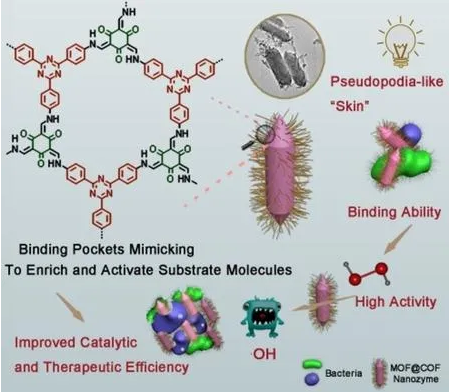
Metal–organic frameworks (MOFs) have sparked increasing interest in mimicking the structure and function of natural enzymes. However, their catalytic and therapeutic efficiency are unsatisfactory due to the relatively lower catalytic activity. Herein, inspired by nature, a MOF@COF nanozyme has been designed as a high‐efficiency peroxidase mimic, with the metallic nodes of MOFs as active centres, the hierarchical nanocavities produced by the growth of covalent organic frameworks (COFs) as binding pockets to form tailored pore microenvironment around active sites for enriching and activating substrate molecules, to perform enhanced bacterial inhibition. Furthermore, the pseudopodia‐like surface of the COFs “skin” enabled the system to catch the bacteria effectively for further amplifying the therapeutic efficiency of MOF‐based nanozyme. We believe that the present study will not only facilitate the design of novel nanozymes, but also broaden the biological usage of MOF/COF‐based hybrid materials.
https://onlinelibrary.wiley.com/doi/abs/10.1002/anie.202012487
Encoding Multilayer Complexity in Anti‐Counterfeiting Heterometallic MOF‐Based Optical Tags
Angewandte Chemie International Edition ( IF 12.959 ) Pub Date : 2020-11-02 , DOI: 10.1002/anie.202013012
Jacob I. Deneff; Kimberly S. Butler; Lauren E. S. Rohwer; Charles J. Pearce; Nichole R. Valdez; Mark A. Rodriguez; Ting S. Luk; Dorina F. Sava Gallis

Optical tags provide a way to quickly and unambiguously identify valuable assets. Current tag fluorophore options lack the tunability to allow combined methods of encoding in a single material. Herein we report a design strategy to encode multilayer complexity in a family of heterometallic rare‐earth metal–organic frameworks based on highly connected nonanuclear clusters. To impart both intricacy and security, a synergistic approach was implemented resulting in both overt (visible) and covert (near‐infrared, NIR) properties, with concomitant multi‐emissive spectra and tunable luminescence lifetimes. Tag authentication is validated with a variety of orthogonal detection methodologies. Importantly, the effect induced by subtle compositional changes on intermetallic energy transfer, and thus on the resulting photophysical properties, is demonstrated. This strategy can be widely implemented to create a large library of highly complex, difficult‐to‐counterfeit optical tags.
https://onlinelibrary.wiley.com/doi/abs/10.1002/anie.202013012



















